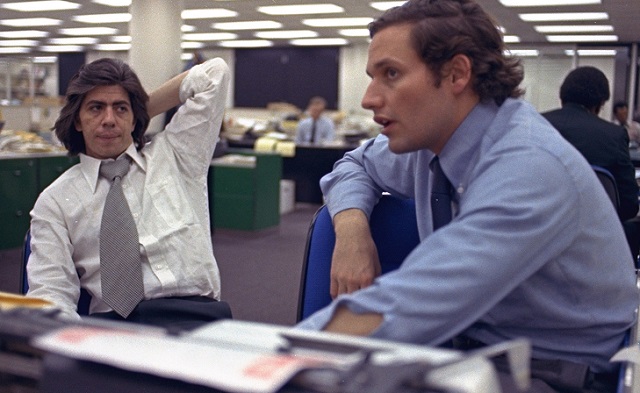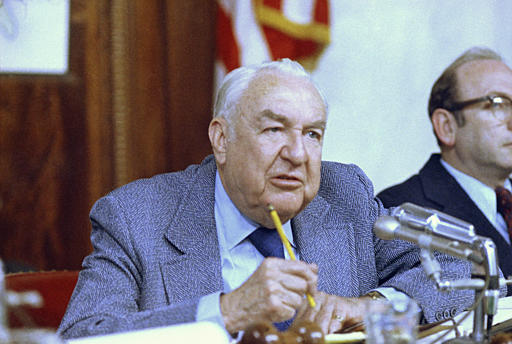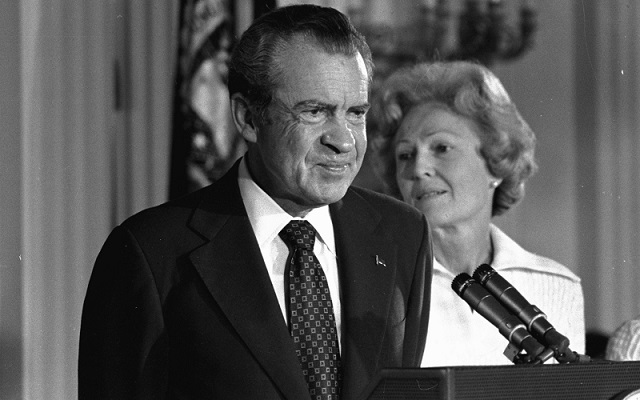PORTLAND, Ore. (KOIN) — Watergate. Maybe you remember it vividly. Perhaps you weren’t born. It’s been in the news a lot lately.
James Clapper, the former Director of National Intelligence, said June 7 that Watergate “pales” in comparison to the controversy surrounding the Trump administration and Russia.
“I have to say, though, that I think when you compare the two, that Watergate pales really in my view compared to what we’re confronting now,” he said at a National Press Club event in Canberra, Australia.
Watergate is the single-word shorthand for the criminal scandal that forced Richard Nixon to become the first and only president to resign from office 43 years ago.
Depending on your age, here is either a primer or a review of the key events and players in Watergate.

The Burglary
On June 17, 1972, five men — Bernard Barker, James McCord, Frank Sturgis, Virgilio Gonzalez, Eugenio Martinez — broke into the Democratic National Headquarters office in the Watergate complex in Washington. They were discovered by security guard Frank Wills, and arrested that night.
The low-level crime piqued the interest of reporters Bob Woodward and Carl Bernstein of the Washington Post. So began an ongoing series of reports that implicated some of the highest-level officials in the Nixon administration and, eventually, President Nixon.
The five burglars were indicted by a Grand Jury in September, along with G. Gordon Liddy and E. Howard Hunt, both of whom had direct connections with the White House.
The election
Richard Nixon won 49 of 50 states in the 1972 election against George McGovern. He entered his second term with a clear mandate but with the cloud of Watergate beginning to form into an uncontrollable storm.
The motive
The Committee to Re-Elect the President (CRP, pronounced “Creep”) wanted to get political dirt on McGovern. The burglars broke into the Democratic National Headquarters to gather information on their campaign.
But what was revealed was a tangled web of operatives, payoffs, hush money and ongoing dirty tricks coordinated by the White House, and approved by Richard Nixon.
The Washington Post
For quite a while, the Washington Post was alone in coverage of the Watergate affair. The 1976 movie “All the President’s Men” conveyed the drama involved and the gravity of the situation for the Post and for the country.
- Warning: graphic language:
Deep Throat
Woodward and Bernstein had a highly placed source who rarely gave them specific information, but rather told them whether they were on the right track. He also told them to “follow the money.”


They protected the identity of Deep Throat until he admitted it shortly before he died.
Mark Felt was the second-ranking official at the FBI and had the access to information very few other people had.
He remained unidentified until 2005 when he broke his silence. He died at the age of 95 in late 2008.
The Senate hearings
By the summer of 1973, the Senate Watergate Committee was holding hearings and questioning witnesses about Watergate.

It was revealed during these hearings that President Nixon recorded every conversation in the Oval Office. Those tape recordings became a focal point for the investigation — and set up a standoff between Nixon and the Congress.
Only after the US Supreme Court ordered the tapes released did Nixon comply. But that was almost a year later, and six months after Nixon had fired the special prosecutor and accepted the resignation of his new Attorney General and deputy Attorney General in what was known as the Saturday Night Massacre.
Once the tapes were heard, it became nearly impossible for Nixon to remain in office.
Spiro Agnew
While the Watergate scandal was enveloping Nixon and key members of his administration, his Vice President was investigated for extortion, tax fraud, bribery, and conspiracy. He pleaded no contest and resigned his office on October 10, 1973, paving the way for Rep. Gerald Ford of Michigan, the House Minority Leader, to become Vice President.
On July 27, 1974, the House Judiciary Committee drew up three Articles of Impeachment against Richard Nixon.
In part, Article 1 said:
On June 17, 1972, and prior thereto, agents of the Committee for the Re-election of the President committed unlawful entry of the headquarters of the Democratic National Committee in Washington, District of Columbia, for the purpose of securing political intelligence. Subsequent thereto, Richard M. Nixon, using the powers of his high office, engaged personally and through his close subordinates and agents, in a course of conduct or plan designed to delay, impede, and obstruct the investigation of such illegal entry; to cover up, conceal and protect those responsible; and to conceal the existence and scope of other unlawful covert activities.
It became apparent Nixon was going to be removed from office by the United States Congress.
Resignation
On the night of August 8, 1974, Richard Nixon addressed the nation. Here’s how Walter Cronkite and CBS News set it up on their evening newscast.
Nixon officially resigned at Noon ET on August 9, 1974.
The pardon
One month later, President Gerald Ford — the only unelected president in American history — issued a “full, free and absolute pardon” to Richard Nixon for any crimes he may have committed as president.
It’s widely accepted this action cost Ford the 1976 election — won by Jimmy Carter — but many historians now regard this as absolutely the right thing to do.
Historians believe a trial of a former president for crimes he may have committed would have totally consumed the federal government for years.
40 years after Nixon resigned
Not surprisingly, on the 40th anniversary of Nixon’s resignation in 2014 the Washington Post put a thorough look at the Watergate affair on their website. Take some time here to learn more about Watergate and its effect on the American political arena.
Is it the biggest American political scandal ever?
That’s for you to decide. There have certainly been others, including the Teapot Dome scandal during the Harding Administration, that combined elements of crime, greed and political machinations.
The current ongoing investigations into the possible connection between the Trump campaign and Russia has many of the same elements: The backdrop of a presidential campaign, dogged journalism, a president with low approval ratings and a cursory relationship with the truth, political operatives, the appointment of a Special Counsel and the smell of obstruction of justice.
But Watergate remains the only scandal that forced a president from office just 21 months after he was re-elected and carried 49 of the 50 states.

The Associated Press contributed to this report.